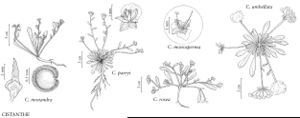Cistanthe parryi
Phytologia 68: 268. 1990.
Plants annual, taprooted. Stems 2 or more from each rosette, spreading to ascending, 2–11 cm. Leaves basal and cauline; basal in single, prostrate rosette; blade spatulate, 1–3 cm. Inflorescences paniculate or racemose scorpioid cymes, becoming secund, open to dense. Flowers subsessile; sepals ovate, orbiculate, or reniform, unequal, 2–5 mm, margins scarious; petals 3(–4), white or pinkish, 1.5–3 mm; stamens 1–3, anther yellow; style absent; stigmas 2. Capsules ovoid to cylindric, 3–7 mm; valves 2. Seeds 10–15, black, orbicular, 0.6–0.7 mm, shiny. 2n = 44.
Phenology: Flowering Jun–Jul.
Habitat: Open, sandy areas, chaparral, woodlands
Elevation: 700-3400 m
Distribution

Ariz., Calif., Mexico (Baja California).
Discussion
Some authorities recognize varietal segregates in this species based on minor characters that appear to exhibit much variation from population to population; they are not treated in this account.
Selected References
None.
